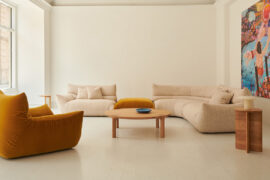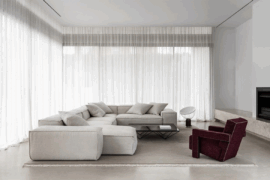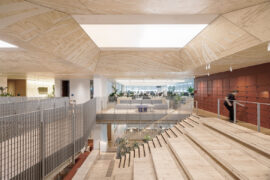Wilkhahn has entered a new territory of design and manufacturing with its concept PrintStool One – a 3D-printed stool that could transform the relationship between brand and consumer.
We’ve seen 3D printing used to make various objects, from toy parts and collectibles to clothing and medical aides. But despite its ubiquity nowadays, we had yet to see the technology being used to manufacture commercial furniture – until Orgatec 2016.
At the fair, Wilkhahn opened a window to a potential new future for commercial furniture design and manufacturing with PrintStool One. Designed by Munich-based industrial designer Thorsten Franck, PrintStool One is an hourglass-shaped stool with cushioned top, a rounded bottom (that encourages movement during sitting) and a textured structural column that is produced with a biodegradable plant-based material using 3D printing technology.
“They are not prototypes because the ‘prototype’ does not exist anymore [in this context],” said Franck when we quizzed him about the specimens displayed by Wilkhahn at Orgatec. He explained, “When you print the stool, you are manufacturing it.” He added, “We designed a system that allows customers to finish the design in collaboration.”
3D printing allows the roles of producer and consumer to merge. The ‘prosumer’ can send their order, control the production, and become the co-designer of the final printed product by determining aspects of its structure and shape, its colour, and even its size. Fast local production raises the possibility of substantial savings in terms of time, cost and emissions.
PrintStool One is a culmination of four years’ research and substantial advancements in terms of technology, material and software. An important aspect of the design is its embrace of the cradle-to-cradle approach. Being made with lignin (a biopolymer material found in plants), the stools printed by Wilkhahn are completely biodegradable.
At the moment, PrintStool One is offered as a numbered limited edition collectible. There’s still a lot to do in order for Wilkhahn to comply with the international norms and standards that are associated with industrial production for the contract furniture business. At the moment, reports Wilkhahn, there are no valid long-term studies on the technical characteristics of the material used, nor on the reliability of the processing technology. That positions Wilkhahn as a pioneer in the field for commercial applications.
Said Franck, “The product is growing. I like this word – growing – being used for a product.” We look forward to seeing the next stage of development.
INDESIGN is on instagram
Follow @indesignlive
A searchable and comprehensive guide for specifying leading products and their suppliers
Keep up to date with the latest and greatest from our industry BFF's!

A longstanding partnership turns a historic city into a hub for emerging talent

A curated exhibition in Frederiksstaden captures the spirit of Australian design

Welcomed to the Australian design scene in 2024, Kokuyo is set to redefine collaboration, bringing its unique blend of colour and function to individuals and corporations, designed to be used Any Way!

For Aidan Mawhinney, the secret ingredient to Living Edge’s success “comes down to people, product and place.” As the brand celebrates a significant 25-year milestone, it’s that commitment to authentic, sustainable design – and the people behind it all – that continues to anchor its legacy.
Cutting-edge machinery and expert design teams are raising the bar on commercial office fitouts

Whilst in Australia with Living Edge, Muuto CEO, Anders Cleeman, spoke on the five principles that shape Muuto’s neuroaesthetic approach to product design, and creating humanistic spaces.
The internet never sleeps! Here's the stuff you might have missed

Jesse Lockhart-Krause, Director of Lockhart-Krause Architects, tells us about a storied building in Queensland that has now become a functional workplace for a therapy centre.

Harbro has it all – beautiful furniture designs that add a sophisticated touch to any room.

Reuse, resourcefulness and material transformations bring unexpected stories to Arup’s new Brisbane office, designed by Hassell.